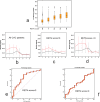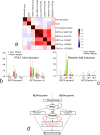Resistin reinforces interferon λ-3 to eliminate hepatitis C virus with fine-tuning from RETN single-nucleotide polymorphisms
- PMID: 27477870
- PMCID: PMC4967850
- DOI: 10.1038/srep30799
Resistin reinforces interferon λ-3 to eliminate hepatitis C virus with fine-tuning from RETN single-nucleotide polymorphisms
Abstract
The effect of resistin (RETN) on the response to anti-HCV therapy remains unclear. A prospective cohort study was performed using 655 consecutive HCV patients, of whom 513 had completed a course of interferon-based therapy. Multivariate and GEE analyses revealed four RETN single-nucleotide polymorphisms (SNPs), rs34861192, rs3219175, rs3745367 and rs1423096, to be synergistically associated with resistin levels. After adjusting for co-factors such as interferon λ-3 (IFNL3)-rs12979860, the resistin level and the hyper-resistinemic genotype at the 4 RETN SNPs were positively and negatively associated with a sustained virological response (SVR), respectively. RETN-rs3745367 was in linkage disequilibrium with IFNL3-rs12979860. Compared to non-SVR patients, SVR patients had higher levels of pre-therapy resistin, primarily originating from intrahepatic lymphocytes, stellate cells, Kupffer cells, hepatic progenitor cells and hepatocytes. This difference diminished over the course of therapy, as only SVR patients exhibited a 24-week post-therapy decrease in resistin. Both resistin and IFNL3 mRNAs were upregulated, but only resistin mRNA was upregulated by recombinant resistin in peripheral blood mononuclear cells with and without hyper-resistinemic genotypes of the 4 RETN SNPs, respectively. Fine-tuned by RETN SNPs, intrahepatic, multi-cellular resistin reinforced IFNL3 in eliminating HCV via immunomodulation to counteract pro-inflammation. These results encourage the development of novel resistin-targeted anti-viral agents.
Figures



References
-
- Chang M. L. et al. Plasminogen activator inhibitor-1 is independently associated with non-alcoholic fatty liver disease whereas leptin and adiponectin vary between genders. J Gastroenterol Hepatol. 30, 329–336 (2015). - PubMed
Publication types
MeSH terms
Substances
LinkOut - more resources
Full Text Sources
Other Literature Sources
Medical

